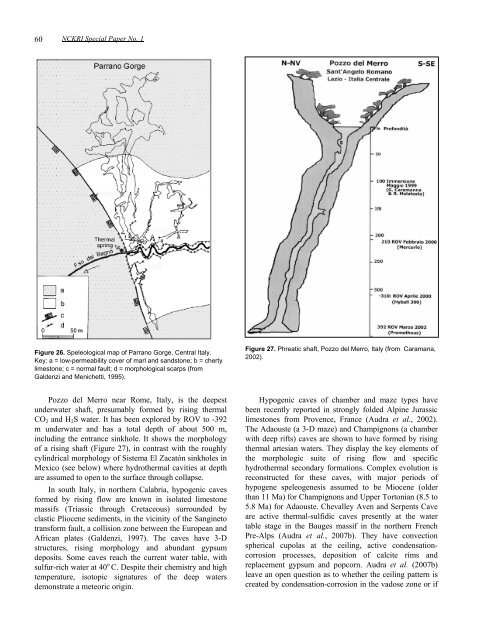Download PDF - Speleogenesis
Download PDF - Speleogenesis
Download PDF - Speleogenesis
You also want an ePaper? Increase the reach of your titles
YUMPU automatically turns print PDFs into web optimized ePapers that Google loves.
60<br />
NCKRI Special Paper No. 1<br />
Figure 26. Speleological map of Parrano Gorge, Central Italy.<br />
Key: a = low-permeability cover of marl and sandstone; b = cherty<br />
limestone; c = normal fault; d = morphological scarps (from<br />
Galdenzi and Menichetti, 1995).<br />
Pozzo del Merro near Rome, Italy, is the deepest<br />
underwater shaft, presumably formed by rising thermal<br />
CO2 and H2S water. It has been explored by ROV to -392<br />
m underwater and has a total depth of about 500 m,<br />
including the entrance sinkhole. It shows the morphology<br />
of a rising shaft (Figure 27), in contrast with the roughly<br />
cylindrical morphology of Sistema El Zacatón sinkholes in<br />
Mexico (see below) where hydrothermal cavities at depth<br />
are assumed to open to the surface through collapse.<br />
In south Italy, in northern Calabria, hypogenic caves<br />
formed by rising flow are known in isolated limestone<br />
massifs (Triassic through Cretaceous) surrounded by<br />
clastic Pliocene sediments, in the vicinity of the Sangineto<br />
transform fault, a collision zone between the European and<br />
African plates (Galdenzi, 1997). The caves have 3-D<br />
structures, rising morphology and abundant gypsum<br />
deposits. Some caves reach the current water table, with<br />
sulfur-rich water at 40 o C. Despite their chemistry and high<br />
temperature, isotopic signatures of the deep waters<br />
demonstrate a meteoric origin.<br />
Figure 27. Phreatic shaft, Pozzo del Merro, Italy (from Caramana,<br />
2002).<br />
Hypogenic caves of chamber and maze types have<br />
been recently reported in strongly folded Alpine Jurassic<br />
limestones from Provence, France (Audra et al., 2002).<br />
The Adaouste (a 3-D maze) and Champignons (a chamber<br />
with deep rifts) caves are shown to have formed by rising<br />
thermal artesian waters. They display the key elements of<br />
the morphologic suite of rising flow and specific<br />
hydrothermal secondary formations. Complex evolution is<br />
reconstructed for these caves, with major periods of<br />
hypogene speleogenesis assumed to be Miocene (older<br />
than 11 Ma) for Champignons and Upper Tortonian (8.5 to<br />
5.8 Ma) for Adaouste. Chevalley Aven and Serpents Cave<br />
are active thermal-sulfidic caves presently at the water<br />
table stage in the Bauges massif in the northern French<br />
Pre-Alps (Audra et al., 2007b). They have convection<br />
spherical cupolas at the ceiling, active condensationcorrosion<br />
processes, deposition of calcite rims and<br />
replacement gypsum and popcorn. Audra et al. (2007b)<br />
leave an open question as to whether the ceiling pattern is<br />
created by condensation-corrosion in the vadose zone or if
















